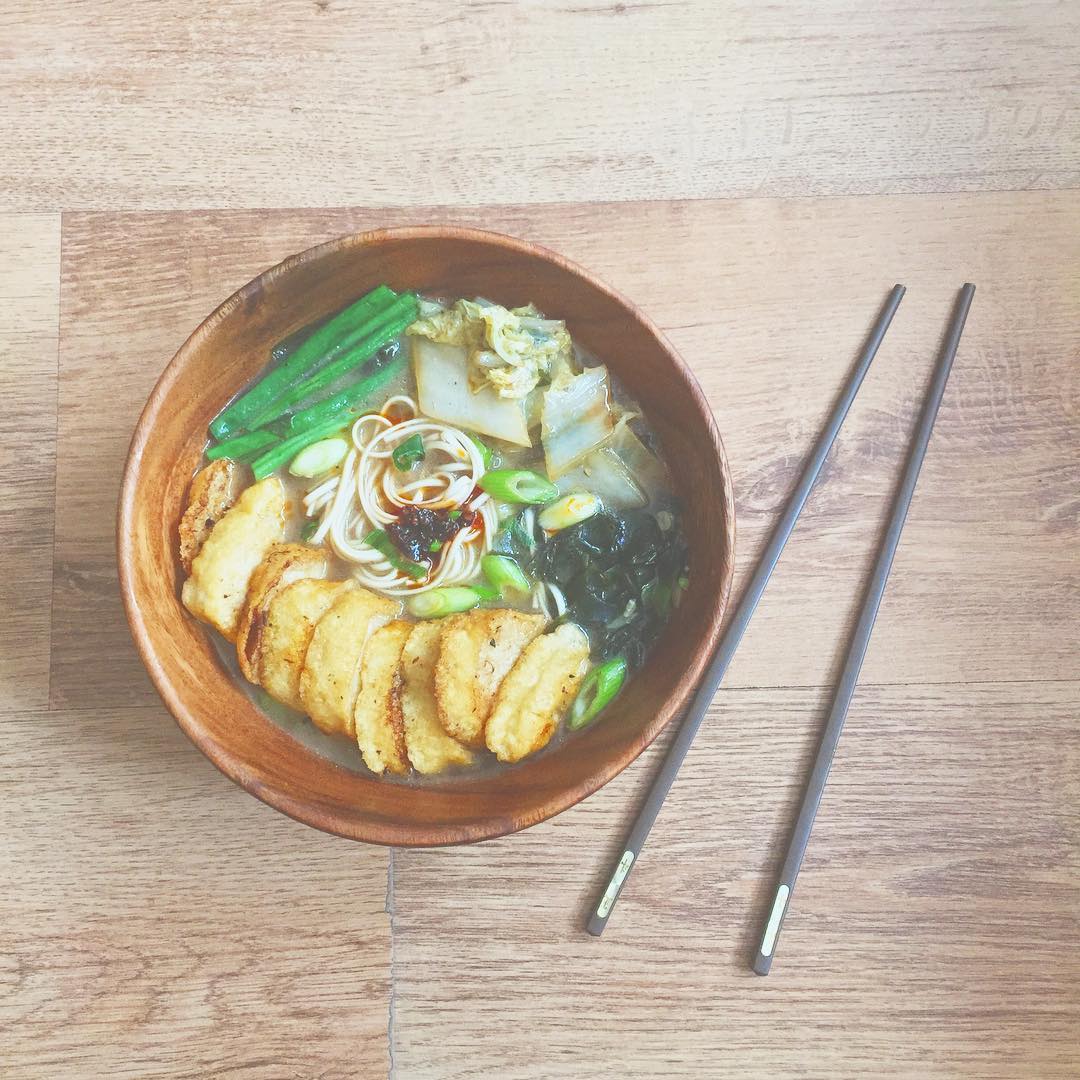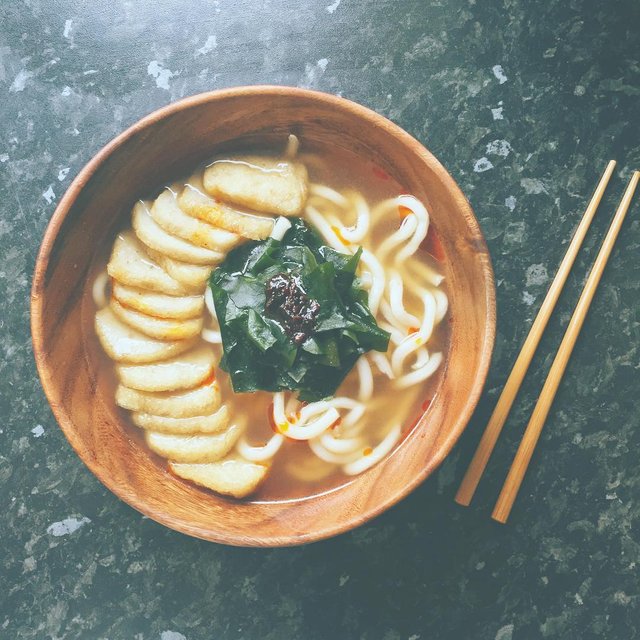KayCalCook's Ultimate Ramen Guide (With Recipe!)

You will know or get to know that I eat Ramen about 3 times a week- and i'm not talking the instant stuff. (okay, you caught me, maybe one or two instant packs of ramen get eaten every now and then but MOST of the time. I'll make it from scratch. I'm obsessed! If you're really close to me then you'll know that this is quite a big post for me because I'm basically releasing how I make my 'Notorious' Ramen Bowl (by 'notorious' I mean that this Ramen bowl that I've shared with friends and family... and family friends... and they all ask how to make it. I've refused to share it until now.)
First off, you're going to have to brave an Asian supermarket for some dry goods... I'm sorry but I can't make my Ramen without all of the ingredients I'm going to mention below. It's not as bad as you think and there are always staff who can help you find things (because believe me when I say, the amount of times I've picked something up thinking I need it and it's something I didn't even think of, is ridiculous.) Luckily, the products I'm on about are dry cupboard goods, so you can keep them in the pantry and they won't go off for a good long while (and you only ever dip in for a little bit at a time)
The Noodle Guide:
Types of Ramen Noodles:
Ramen: The king of noodles in Japan, and worldwide. These thin wheat noodles.
Soba: Are made commonly made of buckwheat, which gives it a different, stronger flavor.
Udon: My personal fave. These are thick and chewy.
Somen: They are much thinner and lighter (basically the polar opposite to Udon)

When you're buying noodles, the best piece of advice I can give here is DO NOT USE EGG NOODLES IN A RAMEN. They are normally covered in starch for the soul purpose of staying succulent and glossy when blasted in a stir fry. When you soak them, the starch can turn your beautifully light Asian broth...Thick (which isn't what you want, no Asian broth in Asia is thick), and the noodles themselves go stodgy and overwhelmingly heavy. And if they overcook, they literally turn into a thick slop.
Once you've got your Asian bits from the supermarket you can hit your normal supermarket for everything else. Good quality Asian or Asian-style noodles are now available in most (if not all) local supermarkets- Some supermarkets even have their own range of them now (like tescos for example.) Look for those! You can determine the better ones to buy because they look and sound Asian, such as Yutaka (They offer dry Soba, Ramen and Udon Noodles). If you're having trouble finding them I'd recommend the Amoy / Sharwoods 'Straight to wok' rice noodles- your noodle-thickness preference (whether you use the thin, medium or udon ones) is completely up to you- but they all use the same cooking method.
The Protein Guide:
Traditionally a Japanese Ramen Bowl would have Tonkatsu Pork, this is slow boiled pork cut into thin slices. The stock is then used for the soup and you slice the pork and stick it on top. Other traditional proteins include Narutomaki which is a type of fishcake, A boiled egg or Fried tofu.
Nowadays, The world of Ramen has changed. So you can basically add just about anything!
But here's the thing... this blog is going to be 100% longer if I specifically tell you how to every type of meat so I'm just going to give you some ideas of what goes great in a Ramen, but really, just make it your own. Fry-up a steak and slice it up, Boil Chicken, HELL(!) Why not Fry Chicken, Tempura some seafood, Roast up some delicious crispy pork belly or duck, Deep fry some Tofu or just cube and boil it. The options are endless. Just do you!
The Stock / Base Guide:
- Dashi Base: An authentic japanese stock, using Kombu Seaweed and Bonito Flakes (THIS IS MY GO TO EVERYTIME!) You can add Soya sauce to this to create 'Shoyu Ramen' or Miso to create 'Miso Ramen'.
- Tonkatsu: Another authentic stock, made from slow boiled pork
- Shio Ramen: Uses Salt, Pepper and Stock - This is great if you're in a rush or if you're hesitant to experiment with real japanese-y stuff. Again, you can add Soya sauce to this to make 'Shoyu' or Miso.
The Veggie Guide:
Asian leafy veg is your go to here. Bok Choi, Pak choi, Choi Sum, Chinese Leaf. That sort of thing. You can throw in Greenbeans or Brocolli spears. Sweetcorn and Bamboo Shoots are also a great topping, as is Japanese pickle or Kim Chi.
RECIPE: KayCal's Bang Bang Ramen (Dashi Broth)
I just want to let you know that I legit go through all these steps EVERYTIME I make my Ramen from scratch. I can't say everytime I make ramen because sometimes I cook instant Ramen... Anyhoo... Once you've made it a few times it becomes less of a ball ache, believe me- I can whip up a bowl in less than 10 minutes now (providing everything's prepared in advance ofcourse). It will probably take you about half an hour on your first try.
Ingredients:
Your Meat / Substitute and Veggies of choice. Cook this seperately, if you fry or roast any meats, keep the juices- You'll know why shortly! In the photo I've featured in this blog, I did some Light-soya-sauce marinated deep-fried tofu.
You will use a Dashi Stock:
- Kombu Seaweed (One sheet per serving)
- Bonito flakes (One tsp per serving)
- Water
For The Broth:
- Cooking Oil
- A minced clove of garlic
- Sliced Green Onions (The white part, use the green to garnish)
- A thumb sized piece of ginger crushed with the flat side of your knife
Optional Garnishes:
- Boiled Egg
- Wakame (soaked in water if you have dry wakame)
- Green onions
- Sliced chilli / chilli flakes / chilli oil
- Thinly sliced ginger or pickled ginger
- Sliced bamboo shoots
So what do I do with all this stuff?
To make Dashi, use one sheet of kombu seaweed and one teaspoon of Bonito flakes per serving. Add these to a pot with about a pint or so of boiling water per person. Boil on high for 5 minutes minimum. The longer you boil it, the better. If you're veggie, leave out the Bonito flakes, you can replace Bonito Flakes with Wakame Seaweed (It's just a little stronger than Kombu). After boiling you want to pour it all through a sieve into a Pyrex jug or a bowl. It should look a bit like dirty dishwater... but clear. Dump the rest (whatever's in your sieve) and leave your stock to one side for now. You can make a massive batch of this and freeze it in portions, as you can with any stock.
Lets save washing and use that same empty pot that you just used, dry it off and add your cooking oil. You only need about a teaspoon or so because you're going to use it to lightly tan your garlic, ginger and the white part of your green onions on a medium heat. Once you get a good whif of those amazing flavours, pour your stock in. WARNING; IT WILL SPIT AT FIRST. (Oil and water are not the best of friends). JUST BRAVE IT AND POUR IT ALL IN- it will stop spitting when there's enough water in comparison to the oil.
Boil a kettle and in a bowl, Soak your noodles and let them sit. You only need to soak them for 5mins. Drain the bowl with your noodles in and rinse them through with cold water (this stops them sticking together.) Don't worry if you think they're too cold to eat, the moment that hot broth hits them they'll warm straight back up.
Back to your pot of broth, season it to your taste with salt and pepper and turn the heat down to a simmer, The longer you keep the broth simmering, the more concentrated the flavour, but to quicken the process I'd say to leave it for about 8 minutes as the broth alone. (This is providing you're not cooking dumplings or any meat products in it, especially if you're cooking meat from raw- If you are, adjust your time to cook meats fully.) At this point you can add whatever you like to jazz it up, a bit of soya sauce for that 'Shoyu' or a stir of Miso. You can also use this broth to cook any veggies or boil an egg. It's just a big hot pot of flavour so use it to your advantage. If at any point you can see the water going down, top it up until it's a decent amount to fill your bowl atleast halfway. Once you've cooking, take the piece of ginger out. Do not put the broth straight in the bowl with your noodles... yet.
Constructing your bowl:
You probably already have your noodles sitting in the bowl you're going to eat from. Add the juices from any cooked meats first to gloss the noodles. If you've fried your main component, drizzle some of that oil (not an excessive amount but a teaspoon or so will do). If you haven't you could also drizzle your noodles with a little sesame oil or if you want a real kick, chilli oil. This is for purely for extra flavour but not compulsary. Then pour in your broth (If you want the broth completely clean of bits of garlic and onion, drain it through a sieve into your bowl- try not to make a mess because I always do). Now, Lay slices of [insert main component here] neatly to one side of the bowl and like a puzzle just fill the spaces with your choice of garnishes. Sprinkle with the green part of your spring onions.
And Voila! One hot, steamy, sexy... okay too far... bowl of KayCal's Bang Bang Ramen.
It looks tasty!! :)
Thanks!
I prepare your meal this afternoon
I would highly recommend it! It's delicious. :)